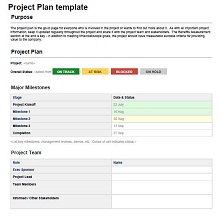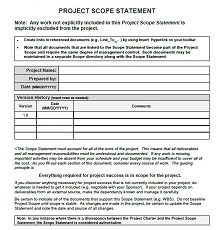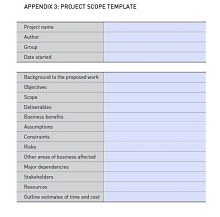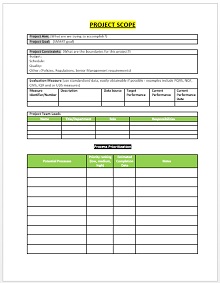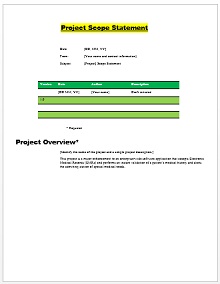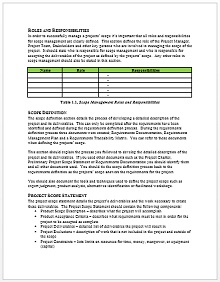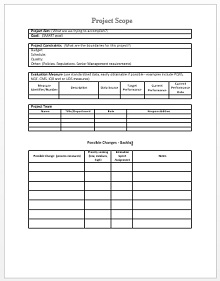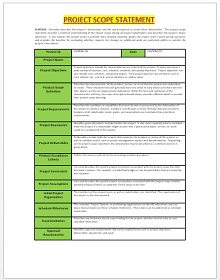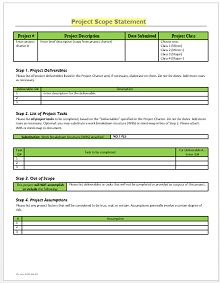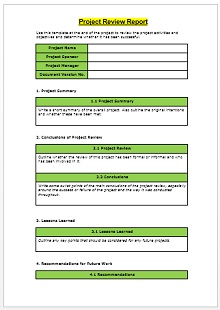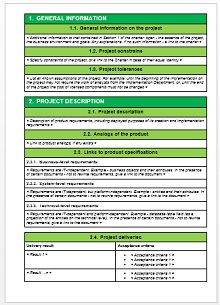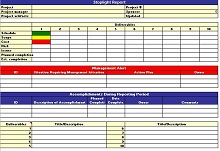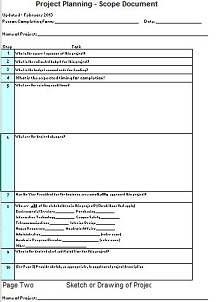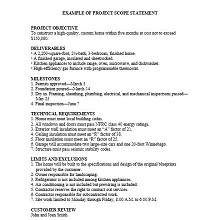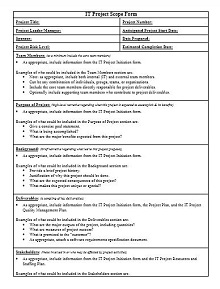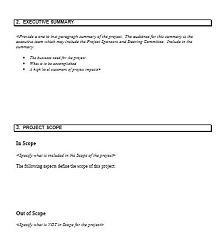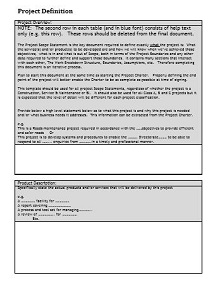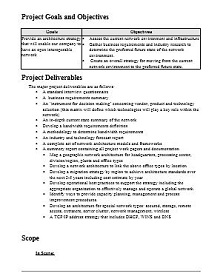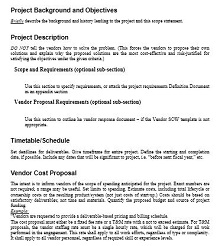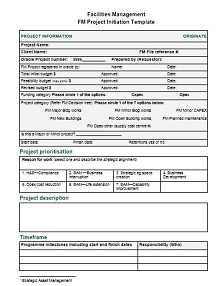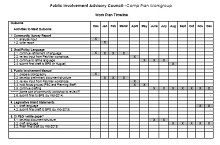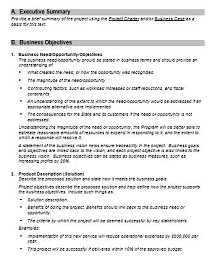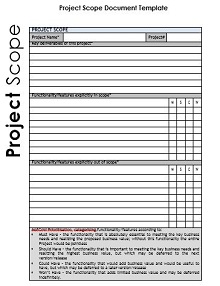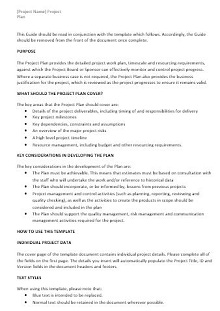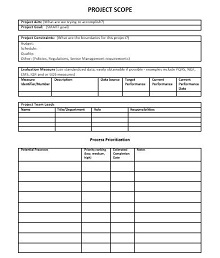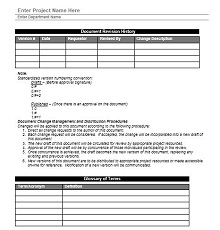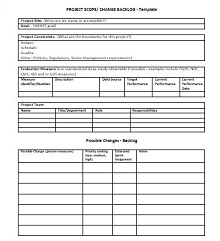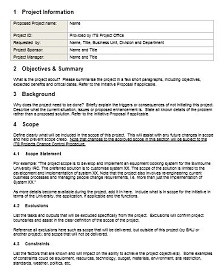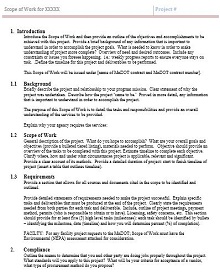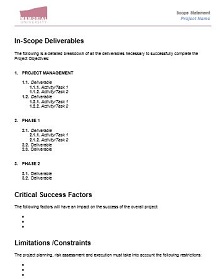37+ Project Scope Templates & Example [Doc]
The scope is a project management term used to define the goals and requirements to complete the project. Project scope templates represent all details about the project. Project scope is the first step of the project plan. It tells how tasks are accomplished to achieve the goal of your project, the time required to complete the project, the cost estimation of your project, project deliverables, project boundaries, and project strategy.
A project scope statement outlines the major deliverables of a project and a description of the work required to accomplish these deliverables. These include the project’s boundaries, defining the project’s budget to complete the deliverable, assumptions, key milestones, assumptions, the deadline to complete this project, top-level requirements, and limitations.
Download Free Project Scope Templates
The project scope template allows you to document all the factors of the project that define your project efficiently. You can download free project scope templates and examples in Word and PDF that help you build a solid project scope document.
A well-defined project scope leads your project to success. The project manager should clearly define what the project delivers to the customer and client at the end. It is the first step in project management that specifies what is in scope and what is out of scope. In this article, you can find everything about the project scope that you want to know.
Here is a collection of project scope templates that will enable you to present all the details about your project to all stakeholders.
- Accounting Templates
- Art & Media
- Budget Templates
- Business Templates
- Calendar Templates
- Certificates
- Charts
- Education Templates
- Inventory Templates
- Invoice Templates
- Letter Templates
- Medical Templates
- Personal Templates
- Project Plan Templates
- Timesheet Templates
What is the project scope?
Project scope defines the expected outcomes of a project including the cost, actions, schedule, and deadlines. It describes the boundaries of the project under which all the actions took place.
The project scope explains each team member’s responsibilities and gives the direction of how all the activities are performed to get the desired deliverables. You can complete your work more efficiently within the deadline. If change is required during the project, then the project scope provides guidelines to make important decisions.
The project manager’s responsibility is to prepare an accurate project scope that defines the project requirement to achieve the expected results. The guidelines set in the project scope specify what to include and exclude in the project based on project boundaries. A well-defined project scope describes every aspect of the project and provides guidelines for the team members and stakeholders to understand their roles.
You can use the short document project charter to describe your project. Effective communication with internal and external stakeholders eliminates the misunderstanding factor and builds a positive work environment that ensures your project is completed within the deadline and budget.
The project manager makes sure that the things in the project process go according to the plan. The deliverable of the project is the expected output which can be one or several. The simple project scope statement templates allow you to describe the project deliverables quickly and efficiently.
Importance of project scope
Successful completion of the project without effectively defining its scope is impossible. The project manager needs to identify the project requirements including the budget, timeline, outcomes, and other aspects that fully describe your project needs. Below we share some important points about the project scope that reflect its importance.
- Change requirements: A project scope is a useful tool that gives an idea of the project’s essential components. The project scope document template offers clues to the manager about what is next and what is going on in the project. If there is any change required in the project, then the project scope helps you make important decisions and helps you manage those changes efficiently.
- Guidelines for stakeholders: Project scope defines the role of all the stakeholders and team members. It provides guidelines for team members about what to do and how to do it. It is an important factor in project management that leads your project to success.
- Budget and deadline: The project manager’s responsibility is to effectively manage the project that meets the deadline and is completed within the budget. The project scope provides direction to accomplish the tasks efficiently that allows you to meet the deadlines and track the cost to complete the project within the budget.
- Define deliverables: The project scope defines what you deliver to the customer or client at the end of the project. It helps to decide the activities, budget, and deadlines of the project to achieve the desired goals.
- Manage the client’s expectations: The project manager should know the client’s expectations from this project by conducting the meetings. The project scope document helps the manager to do all the things in the project that meet client expectations.
What is included in the project scope?
The project scope statement is an essential step in project management that provides a detailed description of project deliverables and other aspects. It contains different elements that describe what and how things will be performed to achieve the desired results.
To be successful in your project, you should include all the key aspects of the project scope to describe your project efficiently. You can visually define your project with the help of a logic model to explain how your project works. It will help the team members and stakeholder to understand their roles and responsibilities. The components of the useful project scope are as follows:
- Project objectives: Project objectives are the goals that the manager wants to achieve to meet the client’s needs. The project objective states what you want to get from this project.
- Project deliverables: Project deliverables are products or services that the project delivers at the end of the phase or project. The deliverables can be one or many.
- Project tasks: The tasks are the activities performed to achieve the desired goals. It also defines the team member or stakeholder who will accomplish it within a specific time.
- Project deadlines: The deadline is one of the critical parts of the project. It describes the target date to complete the project. The project manager needs to complete the project within the deadline.
- Project budget: The estimated cost to complete the project and achieve the desired goals is the project budget. The project manager ensures that the project should be completed within the budget. The project scope allows you to track and control the project cost.
- Project assumption: Assumptions are an important factor in risk management. It states the events you expect will happen in your project based on experience and analysis. Your assumption may be false. For example, you assume that you will get delivery in one hour, but you can’t get it.
- Project limitations: Project limitations are the boundaries under which team members and other stakeholders accomplish the task. It is specified by the project manager what to include or exclude from the project.
Steps of project scope management
After identifying the project scope, the next step is to manage the project scope effectively. It is vital to control, manage, and validate the project scope with a process. The project scope management process allows us to monitor the project actions, validate the project scope, and make changes where needed.
It also ensures the accomplishment of all the tasks of the project time to achieve the desired goals. You can download the project management example template in different formats to manage your project scope effectively. The steps in the project scope management process are as follows:
- Plan scope of the project: The plan scope guides how the project scope will be defined, managed, and controlled. It also explains the plan to handle the unexpected events in the project’s life cycle, how to manage the client’s expectations, the project scope statement, and other essential elements of the project.
- Collect requirements: This process allows you to collect the project requirements from all the stakeholders by using different techniques and tools. All the stakeholders identify the project requirement and then define and document it to achieve the project needs. It provides you with guidelines about your stakeholder expectations.
- Define project scope: When you identify the project requirements and understand the project outcomes, it’s time to define the project’s scope. The scope of the project decides what action or activity is in scope or out the scope. The project scope provides a detailed description of cost, tasks, deliverables, schedules, and other elements.
- Create Work Breakdown Structure: It is the process of breaking the project work into small components to get effective deliverables. These smaller components of work are easy to manage and give the expected results.
- Validate scope: It is a way to ensure whether the project process is in the right way or not. The project manager verifies the project’s scope by formally reviewing the deliverables by the customer or client. It occurs when a phase of the project is completed, and the project manager wants to verify whether the deliverables are according to the client’s expectations or not.
- Control project scope: It is the part of project monitoring where project managers monitor the project and product scope from start to end of the project. This process also controls and manages the changes required by the client, customers, or sponsor in the project scope.
Benefits of project scope
A well-defined project scope provides guidelines to achieve the desired outcomes of the project. The project scope template with a checklist makes it easier to create an adequate project scope that includes all the essential elements. It provides you with lots of benefits to complete your project. Some significant benefits are as follows:
- Effectively describe the project deliverables that help to get the expected outcomes of a project.
- Provide guidelines for all the stakeholders to understand their roles and responsibilities in the project efficiently.
- Outlines the major deliverables of a project.
- Set the boundaries for the project to decide whether a certain action or activity is in scope or out.
- Risk identification is done at the early stage of the project and defines the steps taken to reduce it.
- Helpful to achieve the expected outcomes.
- It helps to complete the process of the project within the budget and deadline.
- Build a great relationship with stakeholders and team members that helps to focus on the same target.
- Helpful to meet the expectations of the clients, customers, or sponsors.
How to define the scope of the project
Project scope is an essential tool that describes every aspect of the project. It states the project’s significant deliverables and includes detailed information on cost, deadlines, schedule, assumptions, and constraints required to accomplish the desired outcome. The project scope of work templates helps you to define the major components of the project quickly. The process to define the scope of the project contains the following steps:
- Identify the project requirements: It is the first step of scope definition to describe what the project wants to achieve and which elements are required to accomplish the desired goals. This step is to work as a basis to define the project scope efficiently.
- Determine project objectives and goals: The SMART guidelines help identify the project’s objectives and goals easily. The SMART definition of the aim of project goals should be Specific, Measurable, Achievable, and Realistic accomplished within the time frame.
- Identify the project scope: What are the boundaries under which the activities or actions of the project are performed? When you determine the project goals, the next step is to identify the project scope, define the project deliverables, and identify the factors involved in achieving the deliverables.
- Defining the project scope: The project scope outlines the major project deliverables, budget to achieve the desired goal, schedule, task to perform, constraints, and assumptions. Define how your project will accomplish all the jobs and get the desired results.
- Change management: It is vital to manage the change in the project scope effectively. Minimal change takes more time, effort, and money. If the change is required, all the stakeholders should understand why this change is occurring and the impact of this change on the project.
Frequently Asked Questions
What are the components of a project management plan?
The three components of the project management plan are planning, controlling, and closing.
What is scope risk?
An unexpected event that occurs in the project that may impact on the project objectives is called scope risk.
What is scope creep?
When the project scope is not clearly defined, and uncontrolled changes occur in the project scope is called scope creep.
What is the work breakdown structure?
The process of subdividing the project work to get effective deliverables is called a work breakdown structure.
What are the deliverables in the project?
Deliverables are outcomes that a project delivers at the end of a phase.
What is the purpose of scope management?
The purpose of project scope management is to ensure that all the essential factors are included in the project scope to get the desired results.

